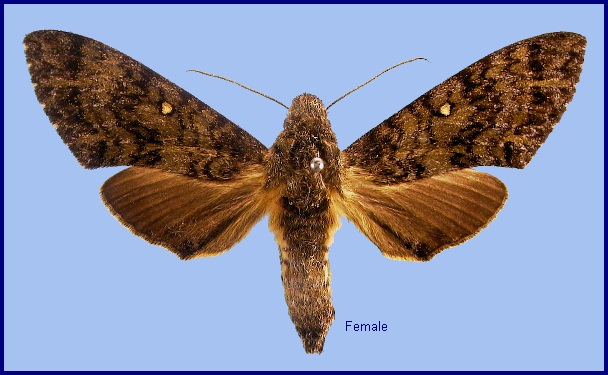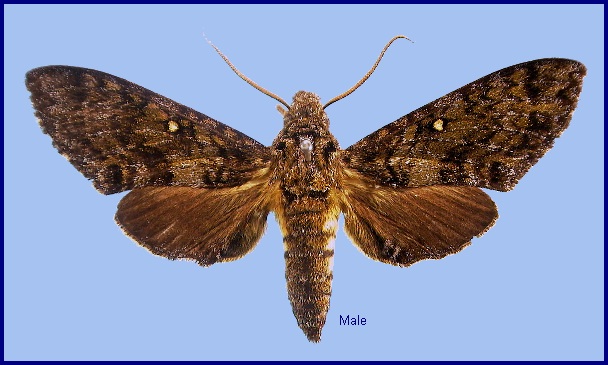

Zonilia fo Walker, 1856, List Specimens lepid. Insects Colln. Br. Mus. 8: 195. Type locality: North India.
Synonym. Zonilia fo Walker, 1856.
Synonym. Pseudodolbina veloxina Rothschild, 1894.
Wingspan: 60--68mm. Similar to Pseudodolbina aequalis Rothschild & Jordan, 1903, but upperside of body and wings darker and less yellow in fresh specimens, dusted with grey scales; mesothoracic tegula with a short black vitta; abdomen upperside with yellow spots of proximal segments larger; palpus with yellow colour more sharply defined; foretarsus more extensively yellow on the upperside; hindtibia with spurs of unequal length, one being about 1.3x as long as the other; both wings upperside with fringe more yellow; forewing upperside discal spot larger; space between the two lines proximal to the discal spot not filled with black scaling.
In the male genitalia, harpe ending in a single, prominent, pointed process directed dorso-distad; phallus with tooth a little longer than in Pseudodolbina aequalis.
There appears to be only one brood in the year in India, as eggs and larvae are not found until the monsoon is well established (Bell & Scott, 1937). An inhabitant of high altitude evergreen broad-leaf forest.
China: 16.v (Mutuo County); 1.vi (Mutuo County).
OVUM: Bright green, spherical, smooth and shiny. Large for the size of moth. Laid singly on the underside of leaves of Strobilanthes, which appears to be unique as a hostplant for sphingid larvae (Bell & Scott, 1937).
LARVA: Full-fed 60mm, width 7mm, horn 12mm. According to Bell & Scott (1937), in the first instar head round and large, body cylindrical; horn strongly bifid, with a bristle on each point. Colour of head and body pale yellowish green, with short, scattered white hairs; horn black.
In the second instar, head round and of considerably larger diameter than the cylindrical body, which is long and slender; horn rather long, thick at base and tapering rather sharply to a strongly bifid tip. Surface of head and body dull, that of horn shiny and covered with short black hairs; colour of the head yellow, body bluish-green, with short scattered white hairs; horn black (Bell & Scott, 1937).
In the third instar, head slightly bilobed, body nearly cylindrical, long for its diameter. Horn long, thick at base and tapering evenly to a bifid tip. Surface of head and body dull, with three transverse rows of small tubercles on segment 2. There is a pair of large tubercles, one on each side of the dorsal line, at about the middle of 3 and 4, with a transverse row of smaller tubercles in front of and behind each pair; remaining segments with transverse rows of very small tubercles in the dorsal area. Horn shiny and covered sparsely at the base, thickly towards the tip, with tubercles. Colour of head bright green with a broad yellow stripe down each cheek from the vertex of each lobe to base of antenna; mouth-parts pale blue. Segments 2 to 4 of the body bright green, rest of body pale bluish-green in the dorsal area, dark bluish-green dotted with white below the oblique lateral stripes, the tubercles all yellow. The lateral stripes on 5 to 11 formed by a triangular white patch on each segment with a black stripe above it, the black stripe broadest on 5 and very narrow on 11 and 12. Horn pale blue with an orange patch on each side of the base, and the tubercles and tip black (Bell & Scott, 1937).
The fourth instar is as above, except that the cheek-stripe is white; the body with segments 2 to 4 as above, the rest of the body yellowish-green. Oblique lateral stripes as above, except that the portion of the last oblique stripe on 12 is yellow. Horn bright blue on dorsal surface, green on lateral and ventral surfaces, with black tubercles as above. The stripe at base of horn red instead of orange; anal flap edged with yellow and with two large green tubercles covered with short white bristles (Bell & Scott, 1937).
In the fifth instar, head about as high as segment 2, semi-elliptical, dorsal line of vertex strongly impressed; true clypeus less than half height of head, basal angles rounded and tumid; apex of false clypeus acute and reaching to one-half length of head; labrum half as long as clypeus and slightly broader, narrowing frontad; ligula semicircular in shape. Body long and slender. Horn very long, thick at base tapering gently to near tip, then becoming broader and flattened above and below, dividing into a blunt fork, the arms rounded and setiferous; the end of the anal flap tumid. Surface of head and body dull and smooth, each secondary ring set with large, smooth, low, oval tubercles. On segment 2 there is a transverse row of six larger tubercles on the front margin, a row of six on the hind margin and a row of four between these two rows. On segment 3 there is a very large, fleshy, subdorsal, conical tubercle, and on 4 an equally large but more rounded dorso-lateral tubercle; on 14 a similar but smaller one on each side of the dorsal line, the tubercles on 14 each bearing two setae, one behind the other. horn closely set with conical tubercles (Bell & Scott, 1937).
Head green with a broad yellow cheek-stripe from near vertex to base of antenna; labrum and ligula whitish-green; basal segment of antenna white, the others pale green; mandible spare green at base, rust-coloured in middle and black at tip. Body green, the tubercles yellow, giving it a mottled appearance. Oblique lateral stripes are present on segments 5 to 11, each extending backwards to near the dorsal line of the adjoining segment behind, that on 11 broader than the rest and running to base and for a short distance up, the side of the horn. These stripes are white near each spiracle, yellow behind it and edged broadly above with dark green. Horn dark blue with tip paler blue, and a crimson stripe up the side from base touching the upward extension of the oblique stripe and extending higher up the horn; tubercles on dorsum of horn black; anal flap edged with yellow. True legs, prolegs and claspers green. Spiracles large, oval, white with a broad reddish-brown band across the middle, the whole with a narrow, green rim (Bell & Scott, 1937).
PUPA: 42mm. Colour dark chestnut, head and cremaster nearly black. Body slender and sharply pointed; the free tongue-case very thin up to the clubbed tip, its base directed forward in the same line as the axis of the body, the sheath then turning in a high arch, the clubbed tip reaching to middle of wing-case, where it touches the ventral surface of the pupa. Eye rather prominent, and just behind it the dorsal surface of the pupa rises first steeply then gently to the middle of the body, forming a kind of step. Antenna mid-way in length between fore leg and mid-leg in both sexes; coxal piece very narrow. Surface shiny; head prominently corrugate-rugose, tongue-case transversely ridged. Veins of the fore wing prominent but not beaded, costal vein finely, transversely striate, surface of wing-case transversely lined; hind wing shows beyond the hind margin of the fore wing under the spiracle of 6. Thorax and abdomen with transverse corrugations, except on the front bevels of 9, 10 and 11, which are coarsely pitted; no sculpturing on 4; ante-spiracular ridges on 9 to 11, with four distinct ridges on each in two pairs and a smooth broad channel between each pair. Spiracle of 2 indicated by a long dull black transverse band; spiracles on the other segments small, oval in shape, and including a more narrow oval with a thin raised rim. Clasper-scar on 14 a deep, longitudinal, rather, long furrow, with a tumidity on each side of it, forming an oval mouth-shaped organ. In the male pupa the sex-scar is a circular mouth with rather prominent lips; in the female the ventral margins of 14 and 13 are arched forwards, and the sex-scar is a small depression in the middle of 12, with a similar depression on 13. Cremaster with a highly polished surface, stout, triangular, very narrowly and, shortly bifid at the tip; dorsal surface rugose, ventral surface shallowly hollowed out, the hollow oval in shape. Pupation takes place in a cell underground (Bell & Scott, 1937).
Larval hostplants. Unknown in China, but recorded on Strobilanthes alata and Strobilanthes pentastemonoides var. dalhousieana (Acanthaceae) in northeastern India (Scott, 1941).
Unknown.
China: Xizang/Tibet (Mutuo County, 1840m).
Nepal, Bhutan (Irungbam & Irungbam, 2019) and northeastern India (Arunachal Pradesh; Meghalaya) into Xizang/Tibet, China.

Map: Distribution of species of the genus Pseudodolbina in Asia. The blue dots indicate records of Pseudodolbina fo fo, the red dots indicate records of Pseudodolbina fo celator, the orange dots indicate records of Pseudodolbina aequalis, and the green dot indicates the type locality of Pseudodolbina yunnana (© Jiang, Yan, Wang & Hu, 2024).
Oriental.
 Return to Sphingidae of the Eastern Palaearctic species list
Return to Sphingidae of the Eastern Palaearctic species list